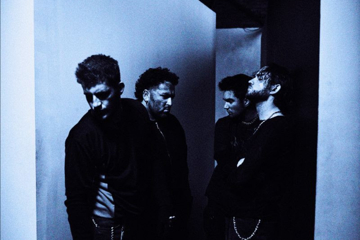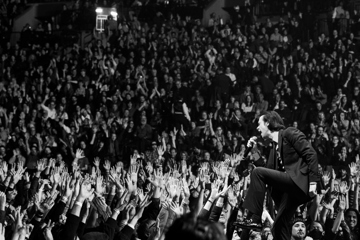Greg Sestero On The Beautiful Truth Behind A Cinematic Disaster
"It was conceived in the mind of one man who believes the world works a certain way, believes that he's going to have his own planet, who went out and inflicted his vision on the world"
When Greg Sestero set out, alongside writer Tom Bissell, to pen his 2013 memoir The Disaster Artist: My Life Inside The Room, The Greatest Bad Film Ever Made, he was thinking about movies. Front of mind was, unsurprisingly, The Room; the 2003 so-bad-it'll-break-your-brain midnight-screening cult movie that was written, directed, produced and starred in by the mysterious, baffling Tommy Wiseau. But he was also writing the book in the hopes that it'd get made into a movie. And, he thought of its story — his friendship with Wiseau, the making of one of the worst films of all time — in terms of films.
Sestero loved My Best Fiend, Werner Herzog's documentary about his relationship with his loose-cannon leading man, Klaus Kinski. Ed Wood was a natural inspiration; a portrait of another infamous hack that hinged on the unlikely friendship of its titular character and ageing monster-movie icon Bela Lugosi. Sestero also loved Sunset Blvd, Billy Wilder's noir Hollywood satire, which finds an unsuccessful young screenwriter lured into the delusional world of a faded screen siren. The agent tasked with getting the book turned into a film suggested My Favorite Year, in which a young TV-variety-show writer is sucked into the vortex of a drunken former matinee idol, played by Peter O'Toole and modelled on Errol Flynn. And Sestero identified with, perhaps troublingly, Boogie Nights, a film about a hot young beefcake drawn into a dark, dysfunctional world.
"My goal, when I was [writing] the book, is that it would be its own film," says Sestero, 39. "The film that Tommy wanted to make, with The Room, was so misguided that it became something else entirely. I realised that the story that he wanted to tell was this [the making of The Room] story, he just didn't know how to do it. I hoped this story — about unlikely friendship, about following your dreams — could be something great. I wanted it to become its own Ed Wood. Which was not an easy task to convince anyone of."
And yet, Sestero's dream has become reality. The Disaster Artist, the to-screen translation, has arrived. It's directed by James Franco, who also plays Wiseau; there were meta-moments on set where Franco stayed in character as he directed, while on screen playing a character who was directing. Dave Franco plays Sestero; marking the first film the brothers have worked on together. A host of Hollywood heavies appear in major roles (Seth Rogen, Zac Efron, Josh Hutcherson, Alison Brie, Ari Graynor, Jacki Weaver, Sharon Stone, Melanie Griffith etc) or cameos (Bryan Cranston, Judd Apatow, JJ Abrams, Kristen Bell, Lizzy Caplan, Keegan-Michael Key, Adam Scott etc), oft in on the great joke that is The Room.
Don't miss a beat with our FREE daily newsletter
"It was conceived in the mind of one man who believes the world works a certain way, believes that he's going to have his own planet, who went out and inflicted his vision on the world"
While that sounds like a lark, Oscar-buzz is building behind The Disaster Artist, the "sincere and heartfelt" qualities carrying as much weight as the mockery of filmmaking ineptitude. It recounts Sestero's story: as teenage acting student in San Francisco, he befriended the weird older guy with the ridiculous European accent, leading to an enduring relationship that finds him moving to LA to live in one of Wiseau's houses and, eventually, becoming a willing collaborator in a mythically bad movie ("Once I signed up to help Tommy, I was in it so deep. I just felt like I couldn't run," Sestero offers. "I figured Tommy would be the only one who'd ever watch it, so I pushed him to make the film that he wanted to make.")
Their relationship is the heart of the film; screenwriters Scott Neustadter and Michael H Weber, seeing the film as just as much of a romance as their previous scripts like (500) Days Of Summer, The Spectacular Now and The Fault In Our Stars. Back before anyone knew them, Sestero and Wiseau were bonded by both loneliness and shared dreams, and ultimatelyThe Disaster Artist is a sentimental shrine to ridiculous dreamers; with James Franco's lead performance going beyond Wiseau mimicry into empathy and pathos. The film chooses to keep the details of Wiseau's backstory — which he famously keeps secret; having issued an injunction against a documentary, Room Full Of Spoons, which discovers his true identity and heritage — out of it, preserving the mystery of its subject. Franco is more interested in recreating scenes from The Room exactly as they were; the closing credits of The Disaster Artist rolling side-by-side splits that show how precisely they nailed it.
The Disaster Artist and Room Full Of Spoons are fine exemplars of an ongoing obsession: films about the making of films. The making of Hitchcock's Psycho, for example, has been portrayed in both narrative feature (Hitchcock) and documentary (78/52). Burden Of Dreams and Hearts Of Darkness, docs about the madness-in-the-jungle making of Fitzcarraldo and Apocalypse Now, are almost as noteworthy as the movies they're about. Recent TV series Feud: Bette & Joan recounted the backstage dramas in the making of camp classic What Ever Happened To Baby Jane and Michael 'The Artist' Hazanavicius's upcoming Redoubtable is about Jean-Luc Godard's life during the making of La Chinoise.
Where often these films are shrines to cinematic greatness, this sub-genre is also evolving into something weirder. Roar: The Most Dangerous Movie Ever Made about a flick whose production — 70 cast and crew mauled by big cats — is more interesting than its result. Raiders!: The Story Of The Greatest Fan Film Ever Made chronicles kids making a shot-for-shot remake of Raiders Of The Lost Ark. And Lost In La Mancha and Jodorowsky's Dune are even greater leaps of imagination: chronicles of movies that never were, failed productions whose potential cinematic promise now lingers eternal.
The Room is a natural recipient of both documentary and narrative treatment, due to how inexplicable it is. "When you watch The Room, it's one big question: How did this get made? What is its purpose? Why was that billboard up there for five years?" Sestero says.
"It was conceived in the mind of one man who believes the world works a certain way, believes that he's going to have his own planet, who went out and inflicted his vision on the world."
For Sestero, though, The Disaster Artist isn't just a movie about a movie, or a movie based on a book based on the making of a movie. It's his life. "It's very therapeutic to see it, to have shared your story. It's not just living inside your head anymore," Sestero says. "When I'd go to screenings of The Room, people would just quote lines at you from the film, 'Oh hai Mark, how's your sex life?', talk to you as if you're not a real person. Once the book came out, people started to connect to my story far more personally. Now, with the film, the conversation is only deepening. The evolution of it has been staggering. The Room has given me so many great things. And, hopefully, there's more to come."
The Disaster Artist is on general release from 8 December.







